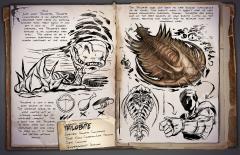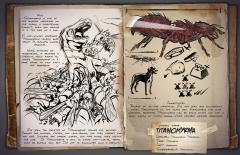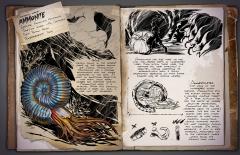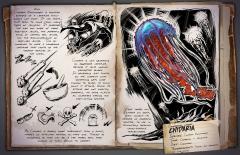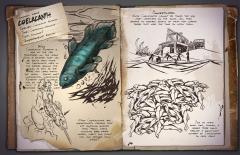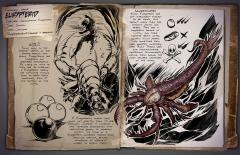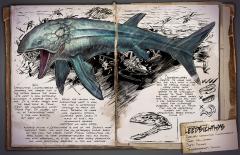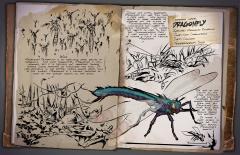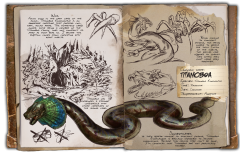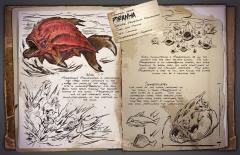Search the Community
Showing results for tags 'not tameable'.
-
From the album: Dossiers
Common Name: Trilobite Species: Trilobite Conchadurus Time: Early Cambrian-Late Permian Diet: Carnivore Temperament: Defensive Wild: Like most Trilobites, Trilobite Conchadurus is an opportunistic carnivore that feeds on anything smaller than itself which it can get a hold of. A sluggish creature, the Trilobite's best defense is its incredibly hard shell. This seems to be a common adaption for the slower creatures of the island. Trilobite is not a very good source of food. The creature seems to be made mostly out of internal organs and its defensive carapace. This is good for the Trilobite, as both river and ocean predators are less likely to prey on it if there are better options around. Domesticated: The Trilobite does not seem to have enough intelligence to be tamed. This doesn't mean it doesn't have its uses among resourceful survivors, though. Trilobites are easily one of the best sources of high quality chitin on the island, assuming one doesn't wish to venture into the dangerous caves. Known Information: Trilobite is not a very good source of food. The creature seems to be made mostly out of internal organs and its defensive Carapace. This is good for the Trilobite, as both river and ocean predators are less likely to prey on it if there are better options around. -
From the album: Dossiers
Common Name: Titanomyrma Species: Titanomyrma parvagigan Time: Paleogene Diet: Herbivore Temperament: Territorial Wild: Titanomyrma is one of the smaller creatures on the island; A frightening thought, when you realize it is the size of a dog. A hive-minded herbivore, Titanomyrma usually goes about it's business unless provoked. When attacked or threatened, it releases a chemical which alerts all Titanomyrma in a large range to help fight the aggressor. I've seen two varieties of Titanomyrma: Drones and soldiers. Drones are smaller, faster and land-bound, and they harvest for the hive. Soldiers are larger, slower and have wings; They defend the hive. If Titanomyrma is akin to other hive-insects, there must be Queens too, but I've yet to encounter such a variant. Domesticated: Because of its hive mentality, I've not seen any successfully tamed Titanomyrma on the island yet. Fortunately for lone survivors, separated Titanomyrma can be easily picked off for a small supply of Chitin among other valuable natural resources.- 1 comment
-
- titanomyrma
- ant
- (and 7 more)
-
From the album: Dossiers
Common Name: Ammonite Species: Ammonitina Multiamicus Time: Late Jurassic - Mid Cretaceous Diet: Bottom Feeder Temperament: Passive Wild: Usually found in the deepest parts of the waters around the island, Ammonitina Multiamicus has a strange relationship with the other creatures of the deep. It must do something beneficial for them, since every nearby sea creature defends Ammonitina when it is attacked. What this distinct symbiosis is based on, alas, I have not yet discovered. Ammonitina has also made its way into the deeper parts of underwater caves. Even within these caves, the creature will draw attention if assaulted, making harvesting its resource-rich shell a tricky proposition depending on what other dangers may be lurking nearby. Domesticated: Like many of the untamable ocean dwellers, Ammonitina still has enough utility to be a valuable hunting target. If a tribe is willing to risk the wrath of nearby would-be protectors, Ammonitina bile can be harvested from it’s corpse’s innards. This bile can be worked over with other chemicals to make many powerful concoctions, usually antidotes against the most powerful poisons and illnesses. Its shell meanwhile, is rich in rare materials, presumably due to the creature’s unique place along the Island’s food chain.-
- ammonite
- late jurassic
- (and 6 more)
-
From the album: Dossiers
Common Name: Cnidaria Species: Cnidaria omnimorph Time: Cambrian - Holocene Diet: Carnivore Temperament: Passive, but aggressive at close range Wild: Cnidaria omnimorph is another example of a creature which should not exist. It has traits that seem to come from many types of jellyfish. It possesses the size and shape of large egg-yolk jellies, the powerful sting of certain box jellies, and the bioluminescence of deep-sea jellies. This all combines to make a dangerous creature that lights up the deepest reaches of the ocean. Cnidaria is not generally an aggressive creature, because it lacks normal perceptive senses. it generally just floats on the current until something gets close enough to sense, at which point it attacks. While its attacks are not directly powerful, its sting injects an incredibly strong and fast-acting sedative. Most tribes kill Cnidaria on sight, then collect its reserve of powerful sedative, to use in technically advanced long-distance tranquilizers. Domesticated: As Cnidaria is barely more intelligent than a plant, there's no effective method to tame one. though dangerous as they can be, a few tribes even keep schools of them around to harvest.-
- cnidaria
- not tameable
- (and 8 more)
-
From the album: Dossiers
Common Name: Coelacanth Species: Coelacanth nutritia Time: Cretaceous-Holocene Diet: Omnivore Temperament: Reactive Wild: Coelacanth nutritia is one of the few creatures on the island with a relative that can be found back home. The Coelacanth lives in the waters around the island, as well as the rivers and lakes within the island. Unlike most Coelacanth, Coelacanth nutritia meat contains less oil and urea. In fact, it is one of the healthier sources of meat on the island. Most Coelacanths are opportunistic feeders that eat anything smaller that itself, likely including baby water snakes, insect and plant life, and perhaps each other? Domesticated: While Coelacanths cannot be tamed the way most creatures on the island can, they provide a possible source of meat for coastal tribes that have the time to catch them.-
- coelacanth
- coel
-
(and 4 more)
Tagged with:
-
From the album: Dossiers
Common Name: Eurypterid Species: Jaekelopterus Euryperus Time: Silurian Diet: Carnivore Temperament: Aggressive if approached Wild: Found only in the deepest depths of the waters around the island, Eurypterids are dangerous and adaptable Arthropods. As likely to hunt as they are to scavenge, a Eurypterid rarely has difficulty finding food to keep itself nourished, even at the bottom of the ocean. A Eurypterid’s threat does comes not directly from its raw strength. Instead, it combines a hard defensive exoskeleton with debilitating poison to powerful effect. The sting of a Eurypterid increases torpor while reducing stamina, quickly rendering its opponent unable to defend itself. Domesticated: While Eurypterid are not intelligent enough to be tamed, this doesn't mean they are without utility for tribes. They are a wonderful source of Chitin, and their digestive tract often contain Silica Pearls. They sometimes even have incredibly rare Black Pearls used for manufacturing mysterious technologies, making them among the most valuable creatures on the island.-
- eurypterid
- invertebrate
- (and 7 more)
-
From the album: Dossiers
Common Name: Leedsichthys Species: Leedsichthys Conviviumbrosia Time: Mid-Jurassic Diet: Piscivore Temperament: Defensive Wild: Leedsichthys Conviviumbrosia is probably the largest fish in the waters around the island. Its meant is also extremely succulent, a surprise given its size. It is often traded with the same value as Prime Meat, and colloquially called ‘Prime Fish’. Of course, not all of Leedsichthys’ meat is this high quality but most of it is! While the demand for Leedsichthys meat is high, the fish is notoriously difficult to track and hunt. Between its large size, powerful attacks, incredible speed (when it turns to flee), and humankind’s general ineptitude on open water, actually killing a Leedsichthys is one of the island’s more difficult tasks. The hunt for an extremely elusive breed of the fish, the fabled ‘Great Albino’ Leedsichthys has been known to drive otherwise-sensible men and women mad with obsession, as if all evil were visibly personified and made practically assailable in this one creature. Domesticated: Despite its large size, and the fact that it may well be strong enough to carry heavy loads, Leedsichthys does not appear to be intelligent enough to tame. Nevertheless, some large tribes keep an enormous pen with a few Leedsichthys trapped inside for cultivating purposes, as bits of prime fish can be repeatedly scraped off the gargantuan beast without killing it.-
- leedsichthys
- fish
- (and 7 more)
-
From the album: Dossiers
Common Name: Dragonfly Group: Invertebrates Species: Meganeura quatpenna Time: Late Carboniferous Diet: Carnivore Temperament: Docile Wild: Meganeura quatpenna is an especially large species of dragonfly. Actually, it is a type of griffinfly, an extinct species of invertebrate that looked similar to dragonflies. Like most griffinflies, Meganeura is carnivorous, but it is typically not aggressive towards humans unless provoked or challenged for food. It lives primarily in the wetter, heavily wooded areas, such as the jungles. Meganeura is a natural predator of most of the smaller insects on the island. Though not often aggressive, Meganeura will not turn down a free meal. They quickly appear in large numbers to scavenge off the victims of Pulmonoscorpius, rendered unconscious and unable to defend themselves. Of course the insects do have to avoid the Pulmonoscorpius itself. I have noticed it is unwise to disturb a flock of feeding Meganeura. The size of the insects on the island confounds me. The way these creatures diffuse oxygen should limit their size but Meganeura (and other bugs) seem to be able to advance beyond this restraint. If there is more oxygen in the air this could explain Meganeura's growth.-
- invertebrate
- meganeura
- (and 8 more)
-
From the album: Dossiers
Common Name: Titanoboa Species: Titanoboa exornantur Time: Paleocene Diet: Carnivore Temperament: Aggressive Wild: Found in the swamps and the dark caves of the island, Titanoboa exornantur is an aggressive creature that prefers cold dark rocky areas. This extremely large snake, while being a member of theTitanoboa family, does not constrict its prey as most boas do. This adaption may come from coexisting with giant insects. Being immune to knockout poisons, and being unable to pierce the thick chitin of the insects, the species have learned to coexist. They often even hunt large prey together. Titanoboahas developed a strange coexistence with the other creatures of the island's caves. Domesticated: As they appear immune to knockout poisons, Titanoboa exornantur is basically impossible to render unconscious. Because this crucial step can't be done, taming this can be a challenge! -
From the album: Dossiers
Common Name: Piranha Species: Megapiranha magnadmorsus Time: Late Miocene Diet: Carnivore Temperament: Aggressive Wild: Megapiranha magnadmorsus is carnivorous fish found fairly commonly in the rivers and ponds of the island. Its bite is incredibly powerful; I've even seen them break through the armored turtles of the island. Megapiranha has one of the strongest bites, pound-for-pound, of any creature on the island. When encountering a Megapiranha, be on the lookout for the rest of the school. No one Megapiranha is an overwhelming threat, but their tendency to swarm prey can make short work of much larger and stronger creatures. Any given Megapiranha is easy to kill, but killing the entire school can be a daunting task. Domesticated: Like some of the other creatures on the island, a tamed Megapiranha is best suited as a guard. Their high metabolism makes them require more food than many other creatures, but they are very adept at hunting their own food, particularly the Coelacanths.-
- aggressive
- carnivore
-
(and 6 more)
Tagged with:
